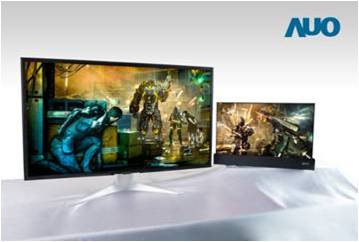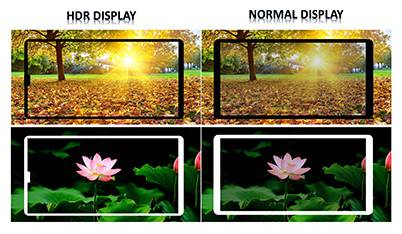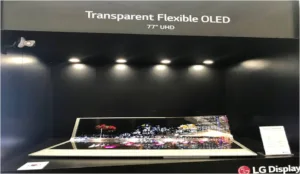DisplayWeek is generally the place to get a glimpse of next generation display products and technologies. This year’s conference was no different. Display supply chain suppliers gave a picture of the future with many prototypes based on MicroLED, MiniLED, OLED and even LCD technology.
MicroLED Display: Coming in the Future
The display industry has been discussing MicroLED for many years, but DisplayWeek 2018 showcased actual prototypes. AUO demonstrated an 8-inch full color, 169 PPI, MicroLED display based on an LTPS TFT backplane with color conversion technology, receiving a “best in show” award for multiple advance displays including MicroLED. Several other companies also showed prototypes especially in the I-Zone. They included DisplayWeek’s honor award recipients, Hong Kong Jade Bird Display and PlayNitride. Hong Kong Jade’s display got honor award for its active matrix microLED display with 5000 Pixel per inch with over 1 million cd/m² brightness. PlayNitride got the award for using its PixeLED display technology to build a transparent display with innovative and unique process to transfer RGB MicroLEDs onto a pixel.
 AUO’s MicroLED
AUO’s MicroLED
MicroLED displays are capable of very high brightness, high contrast ratio, wide color gamut, fast response time, low power, high flexibility and higher transparency. According to suppliers, MicroLED has a simple structure compared to OLED and LCD. It has the potential to be cheaper than OLED, even though it is very expensive now. It still has many manufacturing challenges that need to be resolved before commercialization. Manufacturers are planning to focus more on differentiated product opportunities in automotive, VR, wearable and indoor cinema applications before trying to focus on mainstream general applications such as TV, laptops or smartphones.
MiniLED: Poised to Transform LCD
MiniLED backlights are poised to transform LCD by reducing the performance gap with OLED by improving contrast ratio and reducing response time. They can also help by providing product differentiation in a highly competitive market.
 AUO’s MiniLED BLU
AUO’s MiniLED BLU
MiniLED backlight-based LCD products have the potential to be positioned in between regular LCDs and OLEDs for many different applications including TV, monitors, notebooks, smartphones, automotive and VR. According to suppliers ,MiniLED costs are still high, but it does not need big infrastructure and the manufacturing challenges are not that high. Costs reductions are expected in 2019 and beyond. That is why suppliers such as AUO, BOE, Tianma and many others showcased prototypes of MiniLED-based products in many different sizes and types of applications.
MiniLED backlights can also be combined with direct backlight and local area dimming, to provide very high contrast. Tianma received a “best in the show” award in the large exhibitor category for its 6.46″ HDR LTPS LCD smartphone display prototype, with peak brightness above 1000 cd/m² and maximum local contrast over 3,000,000:1 using mini LED backlights. BOE used MiniLED in its 27″ display to get very high brightness and contrast ratio. AUO displayed many products based on MiniLED including a gaming monitor. With expected high LCD capacity coming from 10.5 Gen fabs in the next few years, MiniLED backlights have the potential to truly transform LCD technology with higher performance and open up new opportunities in the next few years.
OLED: Differentiated Products With Flexible, Foldable, Rollable And Transparent Display
OLED display is ready to shift to the next level by showing truly flexible, foldable, rollable and transparent displays for many different applications including TV, automotive, smartphones, VR, industrial and aviation. LG Display showcased the most unique product ever, a 77” flexible and transparent 4K/UHD display with 80mm radius of curvature and 40% transparency. The possible application markets may be industrial, automotive and aviation. .
LGD and Samsung Display also took VR OLED display to new heights with very high resolutions and refresh rates. LGD demonstrated a 4.3″ 3840 x 4800 (1443PPI) glass based VR OLED display with an LTPS backplane and 120Hz refresh rates. Samsung Display showcased 2.43″ 3840×2160 (1200PPI), VR OLED with 120 Hz refresh rates. Samsung Display also showed a transparent 4.94” AMOLED display with 44% transparency.
BOE, Tianma and Visionox each showed a strong presence with many flexible and foldable OLED displays. Visionox showed many novel application concepts such as flexible eBook, flexible smart wearable phone, and a flexible smart jewelry box. Visionox also received a “best in the show” award in the large exhibitor category for its multiple innovative applications using flexible OLEDs. BOE showed many flexible AMOLED product, including a 5.99″ foldable smartphone and a 7.56″ foldable tablet, with a radius of only 1mm,; it can be bent more than 100K times. Tianma show cased a 5.99″ WQHD foldable/flexible display (best in show nominee).
Many suppliers are working on the development of other components for foldable and rollable displays. For example, BenQ Materials was showing film based solutions, ultra slim polarizers, OCA and cover windows for flexible products. Many suppliers also showed prototypes of OLED automotive displays. Most interesting was Samsung Display’s 14″ 960 x 540 rollable OLED with a bending radius of 10R. Samsung also showed a 12.3″ 1920 x 720 curved (1000R) display and an S-curved 12.4″ 1200 x 1920 display.
LG showed this transparent flexible OLED
OLED already shines in the flexible display market with volume productions popularized by Samsung’s Galaxy smartphones and Apple’s iPhone X products. But a truly foldable/flexible smartphone is expected in the near future. OLED also excels in the VR market with higher contrast and faster response time. A future shift to higher resolutions at more than 1000PPI could really help this application. The automobile market needs design differentiation and OLED displays can fulfil this requirement with flexible display, but lifetime issues can be a real challenge. Many suppliers including Universal Display, Cynora, Kulux and others are working towards improving efficiency, resolutions, lifetime and costs to bring OLED to its full potential. OLED display can provide truly differentiated next generation products with flexible, foldable, rollable and transparent displays.
LCD: Continues To Improve In Spite Of Being a Mature Technology
Display Week this year celebrated 50 years of the LCD. Within LCD technology, even though a-Si TFT-LCD is losing market share for smartphone applications, LTPS LCD is still strong. LTPS LCD is starting to increase its presence in other markets including IT and Automotive. Oxide TFT is also gaining popularity. Organic TFT is opening up novel applications such as the FlexEnable flexible LCD. E Ink showed a flexible 6.8’ ePaper display with an OTFT backplane.
MiniLED backlights can also transform LCD by improving performance especially by enabling higher brightness and higher contrast ratio, allowing LTPS LCD to better compete with OLED. Many companies showed LTPS LCD products for automotive market including JDI.
LTPS improvements was also shown in JDI 1001PPI 3.25”LTPS LCD (2160x 2432) for VR with a response time improved from 4.5msec to 2.2msec, which helps to reduce motion blur, and it can also operate at 120Hz refresh rates.
In the large display side BOE showcased many 8K display prototypes from 13.3″ 8K displays to 75″ 8K TV panels. Companies such as Samsung and AUO are improving LCD performance with quantum dot technology.
 Tianma’s HDR LCD
Tianma’s HDR LCD
Samsung showcased 65″ TV and 31.5″ monitors with quantum dots coated on the glass light guide plate, which gives higher brightness, higher color gamut plus reduced thickness. AUO demonstrated a quantum dot gaming monitor with high performance. Nanosys showed Quantum dot technology as an enabler for next gen LCD, OLED, MicroLED, and emissive QD products with 100% cadmium free materials and ink jet printing solutions.
LCD materials are also improving. Merck KGaA introduced a new liquid crystal single material for advance display performance at the conference. According to the company the new optimized LCD singles will contribute to one of the three categories: XtraBright for ultimate transmission, XtraBrilliant for superb contrast and XtraBoost for unparalleled reliability. With new LC materials, mini LED backlights and multi zone local dimming, LCD can have higher brightness, higher contrast, and better black level enabling it to better compete with OLED.
Fierce competition among display technologies is pushing each technology to innovate and bring new performance and higher capabilities to next generation products. Display Week 2018 gave a glimpse of the future for next generation products, based on MicroLED, MiniLED, OLED and even LCD technology. – Sweta Dash
Sweta Dash is the founding president of Dash-Insights, a market research and consulting company specializing in the display industry. For more information, contact [email protected] or visit www.dash-insight.com

